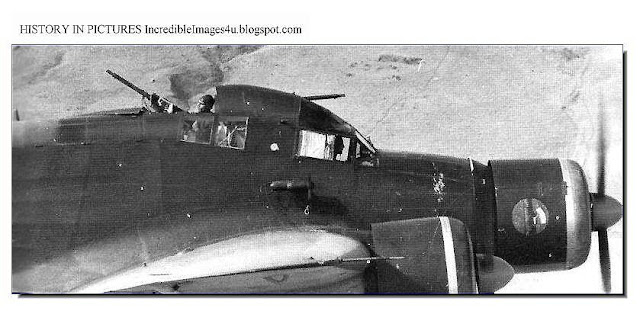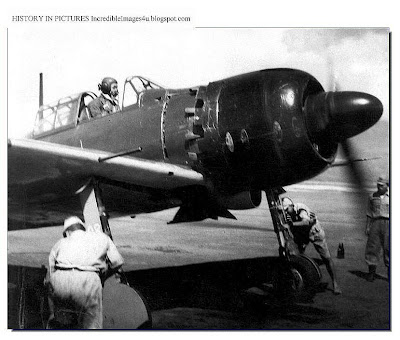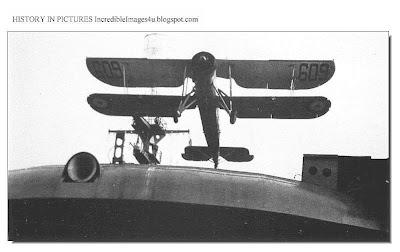
Ki-21, a Japanese bomber on fire
VIDEO: Ki-21 Japanese Bomber

The German long range bomber Condor sinks into the sea after being shot
SOME DOPE ON THE CONDOR
Sir Winston Chrchill called the Condor "The Scourge of the Atlantic ". He came to this because of the enormous ranges that this aircraft could fly, spotting merchant convoys of the Allies. It then could either subsequently attack the convoy with its bombs and rockets, and/or could call in the position to direct German Wolf-packs (groups of hunting U-boats) to the ships.
Starting out as a civil 26-passenger transport, meant for the Atlantic route, it was designed in 1936 with advanced features and performance. Japanese interest in the aircraft resulted in the first semi-military aircraft, and the need for reconnaissance bombers just before the outbreak of the Second World War made the Luftwaffe look into the direction of the Condor. The first aircraft were delivered in september 1939, and the first operational sorties followed in April 1940 during the invasion of Norway.
In the beginning of the war the Condors were almost untouchable, being able to fly out of range for interceptors. The first real operations began in June 1940, and within the span of 3 months already sank more than 90,000 tonnes (91.440 metric tonnes) of Allied shipping. When the Allied had fighters with a greater range the Condors became less successful.
Source
VIDEO: GERMAN CONDOR
Source
VIDEO: GERMAN CONDOR

The Italian The Savoia-Marchetti S.M. 79 Sparviero
THE ITALIAN SM 79
Based on a civil passenger aircraft, the Sparviero was definitely obsolescent, if not obsolete, when Italy went to war. Nevertheless, general opinion holds it as one of the finest torpedo bombers of the War.
The Sparviero entered operational status before World War 2 broke out. Nevertheless it was on active duty real soon with the Aviazione Legionare (Italian Expeditionary Force) supporting the Nationalists during the Spanish Civil War (1936-1939). The performance of the Sparviero during that war led Yugoslavia to order 45 aircraft for their own airforce.
When Italy entered World War 2, there were some 600 aircraft in service, and they and subsequent aircraft have been used in every theatre of operations were Italy was fighting.
When Italy was divided by the Allied forces, the Sparviero served on both sides, in the Aeronautica Cobelligerante del Sud as well as the Aeronautica Nazionale Repubblicana.
In the end the Sparviero had sunk considerable Allied shipping (including 5 destroyers) mostly in the Mediterranean Sea, and had further acted as a reconnaissance aircraft, groundsupport and transport. It even has featured as the worlds first remote controlled bomb. After the War some aircraft have long served as transports and mailplanes.
VIDEO: ITALIAN SM 79 IN ACTION

The Japanese Zero fighters
The Mitsubishi A6M is probably the most famous warplane of the Japanese air forces of World War 2. The A6M is mostly known by it's nickname 'Zero', which comes from the official Japanese designation Navy Type 0 Carrier Fighter. The 0 (zero) stands for the year 2600 according Japanese numbering system, which is also reflected in the name Reisen which means Zero fighter. During 1937 the Mitsubishi A5M had entered service only shortly, and proved to be superior to most contemporary fighters.
The Zero was the the most-built Japanese warplane of World War 2. The number reflects the trust that was placed in the type by the Naval Staff of Japan. Indeed, especially in the beginning the Zero showed an incredible superiority over contemporary enemy aircraft. However, in a later stage of the War the failure to produce a goo dreplacement meant that the Zero was kept in front-line service even after it was rendered obsolescent by the increasingly powerful Allied aircraft.
Source VIDEO: JAPANESE ZERO FIGHTER

The British Fairey Swordfish torpedo bomber
The Fairey Swordfish was a torpedo bomber used by the Fleet Air Arm of the Royal Navy during World War II. Affectionately known as the Stringbag by its crews, it was already outdated when the war started, but was operated as a primary attack aircraft into 1942.
The Swordfish was based on the Fairey PV and was offered to the Royal Navy to fulfill a reconnaissance and torpedo attack role. The prototype TSR II first flew on April 17, 1934. It was a large biplane with a metal frame covered in fabric, specifically for carrier use it had folding wings. An order was placed in 1935 and the aircraft entered service in 1936. By 1939 the Royal Navy had thirteen squadrons equipped with the Swordfish.

The British Tempest
The Hawker Tempest was a RAF fighter aircraft of World War II, an improved derivative of the Hawker Typhoon, and one of the most powerful fighters used in the war.
The Tempest V was in the hands of operational squadrons by April 1944, where it profitably carried on in the low-level attack tradition of the Typhoon, which it was replacing as Tempest production increased. However, in June 1944, the first German V-1ss were launched against London, and the Tempest's excellent low-altitude performance made it one of the preferred tools for dealing with the fast-flying little missiles. Tempest squadrons racked up a considerable percentage of the total RAF kills of the flying bombs.

The American built P 40 Tomahawks in The Russian Air Force
VIDEO: P 40


No comments:
Post a Comment